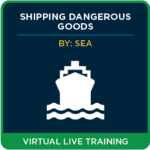
Q: Was there anything else on the box to indicate its character, or the character of its contents? A. No, sir; if there had been, it never would have been sent to the office, and my brother would not have been killed by it.
It seems like safety regulations have been with us forever. And yet, historically, most are pretty recent. My friends and I still laugh about how our parents stuffed armfuls of children into the nearest station wagon without the slightest concern for seatbelts or car seats. In the US, the Environmental Protection Agency was created in 1970, and the Consumer Product Safety Commission wasn’t established until 1972. Many regulations on chemical safety have been around for less than fifty years.
Among these relative regulatory newcomers, though, one stands out – the regulations on transporting hazardous materials (or dangerous goods, to use the terminology of the United Nations). These trace back to the United States, where the first Federal law was passed in 1866. This regulated transport of explosives and flammable materials, and was followed up in 1871 by a law making it a criminal offense to ship certain dangerous substances on passenger ships in US waters. The establishment of the Interstate Commerce Commission in 1887 was the first step in creating a uniform code that applied across the United States and which would eventually cover all modes of transport.
What drove the transport of chemicals to be regulated so much earlier than workplace or home chemical use0 First of all, the US had just ended a four-year war, in which munitions and other explosives were transported in trainloads. Safety problems have a way of showing up in these situations. But the burgeoning economic conditions of the US were also driving industries to invest in new technologies, such as the use of nitroglycerin in mining. And without regulatory guidance, this created, almost literally, a ticking time bomb.
The San Francisco Incident
The accident that many credit with driving the nation’s regulators to action occurred in the city of San Francisco on April 16, 1866. A shipment of unmarked crates had arrived from New York sent through Panama two days earlier at the harbour. Eventually, a wharf employee noticed one of the crates was leaking an oily substance. Concerned, the wharf staff forwarded the package to the office of the carrier of record, Wells, Fargo and Co.
So, what would carriers in 1866 do when confronted with an unmarked package leaking an unidentified material? Perhaps what most of us would do – a Wells Fargo employee named F. E. Webster and some fellow staff decided to pry open the crate to see what was inside. Apparently, this was more to determine who was financially at fault for the loss of product as opposed to some sort of cleanup or amelioration effort. But it was a fatal decision. As a newspaper of the time described the events:
“The last seen of these gentlemen alive, they were standing near the box, with several other employees, having tools as if about to open the box. It is supposed they made the attempt, when the explosion took place by concussion, which resulted in a terrible loss of life and destruction of property.”
The newspaper was accurate. Fifteen people died, including the clerks and many in nearby buildings. Many more were horribly injured. The Wells Fargo office was turned to rubble and extensive damage to buildings could be found for blocks. A photo of the damaged building with its façade missing can be seen here.
And yet, in a regulatory sense, the senders had done nothing wrong by putting a highly explosive substance in insufficient packaging, and not providing any warning to handlers downstream. The only real legal issue was financial – who was responsible for the costs of the damage. In one of these cases, the judges noted that “Common carriers are not chargeable, in cases free from suspicion, with notice of the contents of packages carried by them; nor are they authorized in such cases to require information as to the contents of the packages offered, as a condition of carrying them.”
This horrible accident was followed up a few days later by more terrible news – a freighter in Panama loaded with hundreds of boxes of nitroglycerin destined for California exploded killing fifty people. The public was suddenly very much aware of the risk they’d been ignoring. People started cancelling plans to travel to California by ship and the San Francisco Examiner declared “[t]his thing must be stopped at once.”
Legislators realized that the public needed protection. While it might be possible to ignore the number of workers killed by explosives while building the railroads, a massive explosion in the heart of one of the largest west coast cities was another thing. Explosives, and materials capable of causing explosions, were the first obvious target, but eventually other types of hazards were incorporated. The first regulations were aimed at rail transport and passenger ships, but eventually highway and even the newest form of transport, air, were incorporated.
So next time you think of complaining that we’re overregulated, think of young Mr. Webster, dutifully approaching with a hammer and crowbar towards a nondescript crate, with no labels, no documentation, to let him know it was explosive. He had no idea that what he was doing was dangerous. Nor did the others who were killed or injured that day – the Wells Fargo staff, the waiters in the restaurant next door, bystanders in the street. A study of accidents from pre-regulatory days shows why robust, well-designed regulations are necessary. Without them, our lives, as well as property, are at an unacceptable risk.
Do you have questions on how to ship hazardous materials safely? Are you interested in the newest regulatory developments? Contact ICC Compliance Center here at 888-442-9628 (U.S.) or 888-977-4834 (Canada) and ask for one of our Regulatory Experts. We can advise you on current and upcoming regulations.
Sources:
Princeton, “Transportation of Hazardous Materials,” https://www.princeton.edu/~ota/disk2/1986/8636/863606.PDF
The Transcontinental Railroad, “The Use of Black Powder and Nitroglycerine on the Transcontinental Railroad,” https://railroad.lindahall.org/essays/black-powder.html
Central Pacific Railroad Photographic History Museum, “Nitroglycerine!” http://cprr.org/Museum/Newspapers/Nitroglycerine.html
DGM, “Hazardous Materials History,” https://www.dgm-usa-ny.com/hazardous-materials-history
UCR, California Digital Newspaper Collection, https://cdnc.ucr.edu/?a=d&d=DAC18660421.2.4&e=——-en–20–1–txt-txIN——–1
Stay up to date and sign up for our newsletter!
We have all the products, services and training you need to ensure your staff is properly trained and informed.
 Shipping Dangerous Goods by Sea (IMDG) – Virtual Live 2 Day Training |
 Shipping Hazardous Materials by Ground (49 CFR) – Virtual Live 2 Day Training |
 IMDG Publications |






 ICC USA
ICC USA ICC Canada
ICC Canada